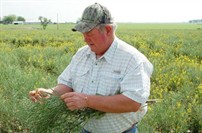Local farmers trying alternative crop
April 2009
by Fred Afflerbach – Telegram Business Writer
Driving along FM 320 outside Westphalia, you may wonder how that waist-high patch of weedy plants survived the county’s mowing machines.
Longtime farmer Curtis Kahlig said a few motorists have pulled over and asked if the elongated seed pods are edible. Not exactly.
Kahlig and his 26-year-old son, Derek, are growing a 30-acre experimental plot of rapeseed.

Despite a dry winter, and spring aphids attacking his 30-acre experimental rapeseed crop, Westphalia farmer Curtis Kahlig is optimistic the plant could work well in rotation with corn. –photo by Fred Afflerbach/Telegram
The plant is grown in Canada and the northern United States to make a cooking oil called canola. It’s also refined into biodiesel.
Kahlig said he’s growing rapeseed because it could work well in rotation, breaking up the yearly corn crop that has dominated farming in Bell and Falls counties the last several years.
Planted around Halloween, Kahlig’s plants suffered from a dry winter. Spring rains have recently coaxed a bright, yellow flower from the woody stalks. But that rain may do more harm than good.
The tiny seeds grow inside an elongated shell that looks like a skinny pea pod. With uneven rainfall, new pods are forming while old ones are maturing. During spring harvest, the older, dry pods will burst and spill on the ground, and the green ones will gum up the harvesting machine.
Research scientist Rick Haney has experienced this dilemma first-hand. He’s growing his second rapeseed crop over at the Grassland, Soil and Water Research Laboratory in Temple.
There’s a window of opportunity in there. Some of the seeds will be ripe . . . and the pod just opens and the seeds go flying out. You want to get it right before then,” Haney said. “If it’s real dry, as soon as your combine header hits it – BAM – it pops the seeds out. It’s just tricky.”
Haney said northern farmers have used two harvesting methods with success: Push the plant over mechanically, or cut it off at the ground, and let it dry for a short time to gain seedpod uniformity.
“They just take it and chop it . . . pile it up like you’re getting ready to bale it,” Haney said. “And they run that through a special combine.”
Because Central Texas has received sparse rainfall the last two winters, neither man knows what yield could be expected under optimum growing conditions.
But Haney said canola oil makes good fuel for diesel engines with few side effects. He’s experimented with canola, soybean and sunflower oil. Even though canola produces the lowest yield, the center’s Ford tractor and Chevrolet pickup both run best on biodiesel made from canola.
Over at Zabcikville, seed dealer Glenn Marek said Monsanto Corp. furnished free seed to farmers such as Kahlig because they, too, want to see how it would perform in Texas.
Marek said it is a good rotational crop because of a deep taproot.
“It really is good for your soil because it goes down pretty deep and it has a big root system underneath there,” Marek said. “This crop is probably a pretty good soil builder. A good rotation is following a tap root with a shallow root crop.”
Sometime next month Kahlig will have to determine how he will harvest his 30 acres. When he does, trucks will probably haul it to Oklahoma because there are no nearby processing facilities.
–Reprinted with permission of Temple Daily Telegram
